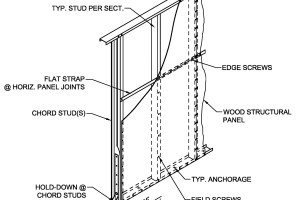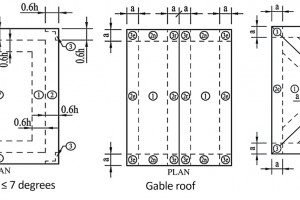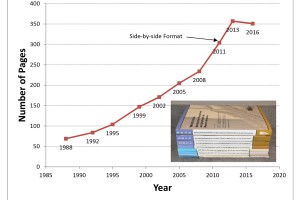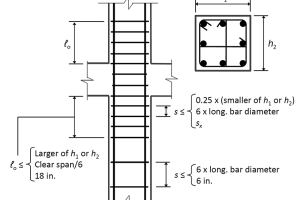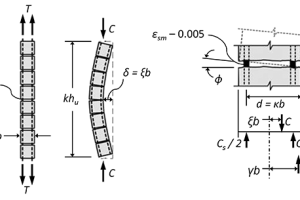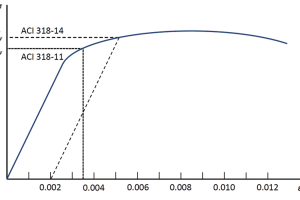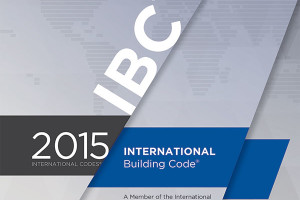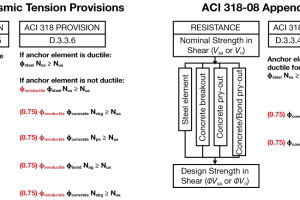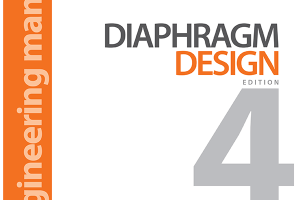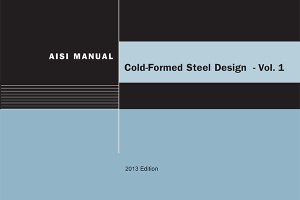In 2015 and early 2016, the American Iron and Steel Institute (AISI) published AISI S400-15/S1-16, North American Standard for Seismic Design of Cold-Formed Steel Structural Systems with Supplement 1. This first edition of AISI S400 represents a merging of the following previously published standards: …
Review Category : Code Updates
Determining Components and Cladding Roof Design Pressures
Component and cladding (C&C) roof pressures changed significantly in ASCE 7-16, Minimum Design Loads and Associated Criteria for Buildings and Other Structures. For flat roofs, the corner zones changed to an ‘L’ shape with zone widths based on the mean roof height and an additional edge zone was added. …
Changes to the Masonry Code
A new edition of Building Code Requirements for Masonry Structures and Specification for Masonry Structures was published in 2016 (Figure 1). In addition to technical updates, there were four non-technical changes. The first is that the code and specification are now solely sponsored by The Masonry Society (TMS) and are known as TMS 402 (formerly also designated as ACI 530 and ASCE 5) and TMS 602 (formerly also designated as ACI 530.1 and ASCE 6), respectively. …
Requirements of ACI 318-14
The American Concrete Institute (ACI) published the Building Code Requirements for Structural Concrete (ACI 318-14) and Commentary (ACI 318R-14) in the Fall of 2014. ACI 318-14 has been adopted by reference into the 2015 International Building Code (IBC). There are very significant organizational as well as technical changes between ACI 318-11 and ACI 318-14. …
Design and Detailing Requirements of ACI 318-14
The American Concrete Institute (ACI) published the Building Code Requirements for Structural Concrete (ACI 318-14) and Commentary (ACI 318R-14) in the Fall of 2014. ACI 318-14 has been adopted by reference into the 2015 International Building Code (IBC). There are very significant organizational as well as technical changes between ACI 318-11 and ACI 318-14. A two-part article on the changes was published in the April and May 2016 issues of STRUCTURE magazine. …
Part 2: Technical Changes
The American Concrete Institute (ACI) published the Building Code Requirements for Structural Concrete (ACI 318-14) and Commentary (ACI 318R-14) in the Fall of 2014. ACI 318-14 has been adopted by reference into the 2015 International Building Code (IBC). There are very significant organizational as well as technical changes between ACI 318-11 and ACI 318-14. …
Part 1: Organizational Changes
The American Concrete Institute (ACI) published the Building Code Requirements for Structural Concrete (ACI 318-14) and Commentary (ACI 318R-14) in the Fall of 2014. ACI 318-14 has been adopted by reference into the 2015 International Building Code (IBC). Adoption of the 2015 IBC by cities, counties, and states has been rather slow. However, major adoptions are scheduled to follow. …
The American Concrete Institute (ACI) Building Code Requirements for Structural Concrete (ACI 318) includes provisions for anchoring to concrete in Appendix D (ACI 318-02 through ACI 318-11) and Chapter 17 (ACI 318-14). Anchorages designed to resist seismic load conditions require special consideration. This article discusses the changes between ACI 318-08 Appendix D seismic provisions and ACI 318-11 Appendix D/ACI 318-14 Chapter 17 seismic provisions, and includes a brief discussion about the International Building Code (IBC) seismic anchoring provisions. …
The Steel Deck Institute (SDI) has released the new and long awaited 4th Edition of the Diaphragm Design Manual (DDM04). This new edition complies with the requirements of the new ANSI/AISI S310-13 North American Standard for the Design of Profiled Steel Diaphragm Panels. At 408 pages, the 4th Edition is larger than its predecessor and will be an invaluable resource to structural designers. …
Municipalities have, or are in the process of adopting, the 2015 edition of the International Building Code (IBC). The 2015 IBC incorporates by reference AISI S100-12, North American Specification for the Design of Cold-Formed Steel Structural Members, 2012 Edition. To facilitate the use of AISI S100-12, the American Iron and Steel Institute (AISI) developed the 2013 edition of its Cold-Formed Steel Design Manual (Manual). …

